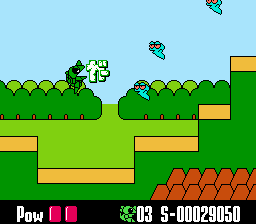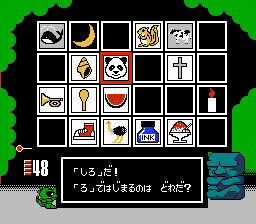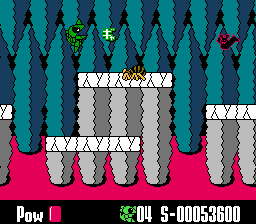It's time to put on a rubber glove and reach into the mystery pouch of random Famicom games! Ooooo! We're going to pull one out and take a closer examination of its enigmatic aura and querical mystique. Alright, let's see what we have here... hmmm... seems to be caught on something... doesn't want to let go...
Wait, this isn't a bag of Famicom games. It's a bag of mechanical lizards! I always get those two mixed up.
Mechanical lizards... hmmm, that DOES remind me of a game series by Namco, now known as Bandai Namco. It was called "Wagyan Land", and it starred a plucky little mechanical lizard named Wagyan. Actually, the entire species was known as Wagyans; a few of them were eventually given individual names, but for the most part, you could just call the main character Wagyan and get away with it. The Wagyan first appeared in an arcade machine as a sad-looking elemecha in a cage, with the sign reading "The Emotional Weapon Voice-Cannon 'Wagan'" (the "y" being implied in this romanization... somehow). It's not exactly clear how the game works, but a plastic megaphone tied to the machine could possibly be held up to the Wagyan, allowing him to use his powerful screeching voice to deflect bullies and parents who wish their kids would put their quarters to better use. The Wagyan must have been popular enough, as he spawned his own game series. Finally able to escape the wretched cage, Wagyan sprinted across the Famicom and Super Famicom with his loud voice throughout the early 1990s. He even resurfaced with a Nintendo DS game in 2009. But we're here to check out his origins with Wagyan Land for the Famicom.
Wagyan Land pits you, the almighty Wagyan, against Dr. Devil, who has captured most of the other Wagyans and plans to use the region for his own malicious desires. But he has no real weaponry at his disposal; he isn't some radical gun-toting robo-iguana. As per his origins as a shouting elemecha, his voice is his weapon. Wagyan must make his way through the various stages of Wagyan Land (connected via the quaint central map), defeating enemies by screaming at them. At first, his call is rather weak... a mere "Wa" (as it's written in the little vocal projectile that flies across the screen). Collecting little Wagyan icons in a stage increases the power level of your cute Wagyan's cries until you find five, at which point he transforms into a hyper Wagyan and is temporarily invincible, though he subsequently loses all power-ups and reverts back to his original state. When an enemy is hit by your voice, it is temporarily stunned. You can stand on it while it flashes, but don't stick around too long, or you'll lose your life! One hit is all it takes.



WA! GAH! GYAAAAN!
This part's fairly easy. You eventually get additional power-ups from the remaining Wagyans, such as the Wag-Copter (letting you do some serious floating) and the Super Waganizer, which is the equivalent of Wagyan's voice amplified 100 times and is able to completely defeat enemies rather than merely paralyze them. It's powerful, powerful stuff.
At the end of most levels, a boss will appear, likely one of Dr. Devil's animatronic minions, perhaps. Looks like there's no choice but to fight in a battle of intonation, right? Well, no, not really. This isn't American Idol, and you are not Ruben Studdard. (Unless you actually ARE Ruben Studdard, in which case, hello, Ruben. Welcome to our site.) Battles are actually played out like card games, and this is where the language barrier truly separates us.
One game is basically a game of memory or concentration, where you have to find more matching pairs than your opponent. Most of the time, it's painfully simple because one half of the playing field usually mirrors the other, so it's easy to find a card's mate. It's the other one that will cause trouble to non-Japanese speakers. Based on the word game of shiritori, you have to find a picture whose first letter is the same as the last letter of the previously chosen image, creating a chain of words. (The cards all have pictures instead of words, so unless you know what each picture is in the Japanese language.) In English, an example would be:
dog --> goat --> table --> esophagus --> steak
This is likely why Wagan Land, and subsequent games in the series, were never localized outside of Japan. It would have required too much effort at a time when translation was a rough enough task, let alone editing an entire gameplay mechanic and all of its graphics. Unfortunately, you cannot win the game without playing shiritori a number of times, so non-Japanese players will be turned off by this part of the game.
With a hearty helping of stick-to-itiveness, Wagyan Land can actually be fun. The platforming stages, simple though they are, provide a relaxing adventure, and with branching pathways at the end of some levels, Wagyan Land has some replay value before you can see the entire Wagyan region. But with the necessary mini-games essentially requiring fluency in another language, it's hardly inviting to an outsider. It's a shame because Wagyan is one cute fellow.


